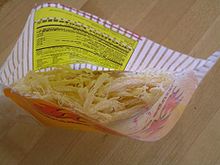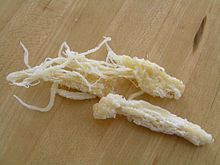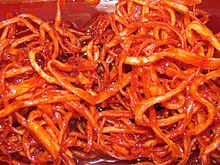- Dried shredded squid
-
Dried shredded squid 
Chinese name Traditional Chinese 魷魚絲 (by strand) Simplified Chinese 鱿鱼丝 Hanyu Pinyin yóu yú sī Cantonese Jyutping jau4 jyu4*2 si1 Literal meaning squid strand Transcriptions Mandarin - Hanyu Pinyin yóu yú sī Cantonese (Yue) - Jyutping jau4 jyu4*2 si1 Alternative Chinese name Traditional Chinese 魷魚片 (by slice) Simplified Chinese 鱿鱼片 Transcriptions Mandarin - Hanyu Pinyin yóu yú piàn Cantonese (Yue) - Jyutping jau4 jyu4*2 pin3 Japanese name Kanji 鯣 Kana スルメ Transcriptions - Romaji surume Korean name Hangul 오징어채 Transcriptions - Revised
Romanizationojingeo chae - McCune-
Reischauerochingŏ ch'ae Dried shredded squid is a dried, seasoned, seafood product commonly found in coastal Asian countries and Hawai'i, made from squid or cuttlefish. The snack is also referred to as shredded squid, dried seasoned squid, prepared rolled squid or sun dried squid, and dried shredded cuttlefish. It should not be confused with regular dried squid found in the Philippines.
Contents
History and origins
Historically, squid is common in Pacific coastal regions of East Asia and Southeast Asia. Only after the packaged form began shipping to English speaking regions, did the translated English-language name "dried shredded squid" get imprinted on packages. The snack was popularized, sold and consumed regularly in Hong Kong during the 1970s. Shredded squid began being sold in Macau as an addition to their almond biscuit. In Japan, dried shredded squid is popularly served as an otsumami (snack consumed while drinking alcohol). In Korean cuisine, dried shredded squid is eaten as anju (food to eat while drinking), and as banchan (small side dishes) such as the dish ojingeochae bokkeum, which is made by stir-frying shredded dried squid seasoned with a mixture of gochujang (chili pepper paste), garlics, and mulyeot (syrup-like condiment).[1][dead link]
Preparation
Northern Pacific squid is separated into different parts and skinned, cooked at 65-80 °C for 3-5 minutes, cooled, grated and seasoned at a temperature below 20 °C for more than 4 hours. Sugar, salt, sorbitol, sweeteners, organic acid and MSG are typical additives.[2] They are then dried at 40-45 °C for 12-20 hours until it reaches a moisture level of 40%. It is then aged in a cold room for 2 weeks or longer, then dried at a higher temperature of 110-120 °C for 3-5 minutes.[2] It is then machine-shredded and seasoned for a second time, dried again to a reduced moisture level of 25-27%. At this phase, the color is yellow or brownish. The amino acids on the squid are revealed by the increase in brown color over prolonged storage time. Vacuum packaging or nitrogen-filled packaging also increase browning. Consumers generally do not want excessive browning.[2]
Packaging
The most common distribution method in today's Asian countries is the pre-packaged format. The bags are usually sealed airtight to keep the squid chewy and tough. Depending on the company doing the packaging or preparation, each brand usually have their own ratio of MSG added on top.[citation needed]
Unpackaged versions are much more rare as they have traditionally been available in select specialty shops, usually sold next to beef jerky.
Contamination
News reports have claimed that arsenic and other toxic metals have been found in DSS packaged in Hong Kong.[3]
See also
References
- ^ http://channel.patzzi.joins.com/article/article_dynamic.asp?aid=7514&Serv=food&Sect1=cook&Cont=[dead link]
- ^ a b c Doe, Peter E. [1998] (1998). Fish Drying and Smoking: Production and quality. CRC Press. ISBN 1566766680
- ^ News Sina. "News Sina." Hong Kong shredded squid has arsenic. Retrieved on 2007-06-08.
 Macanese cuisineAlmond biscuit · Bacalhau · Bakkwa · Cabidela · Dried shredded squid · Galinha à Africana · Galinha à Portuguesa · Mango pudding · Minchi · Pastel de nata · Pork chop bun · Portuguese sauce · Rousong
Macanese cuisineAlmond biscuit · Bacalhau · Bakkwa · Cabidela · Dried shredded squid · Galinha à Africana · Galinha à Portuguesa · Mango pudding · Minchi · Pastel de nata · Pork chop bun · Portuguese sauce · RousongDried fish Bacalhau • Baccalà • Balyk • Boknafisk • Dried and salted cod • Dried shredded squid • Fesikh • Gwamegi • Katsuobushi • Kipper • Kusaya • Maldive fish • Meshawah • Mojama • Piracuí • Sanyaa • Stockfish • Tatami Iwashi • VoblaTaiwanese cuisine Dishes and meals - Bento
- Congee
- Geng
- Karasumi
- Misua
- Mongolian barbecue
- Oyster vermicelli
- Pork ball
- Rice vermicelli
- Sanbeiji
- Shabu-shabu
- Tilapia (braised)
- Ying Yang fish

Xiaochi Snacks and desserts - Aiyu jelly
- Baobing
- Bakkwa
- Caozai Guo
- Coconut bar
- Douhua
- Dried shredded squid
- Grass jelly
- Mochi
- Mooncake
- Onigiri
- Suncake
- Yōkan
- Youtiao
Beverages Ingredients Miscellaneous Cantonese cuisine Main dishes Bao yu • Beef chow fun • Bird's nest soup • Buddha's delight • Cantonese seafood soup • Chinese steamed eggs • Congee • Crispy fried chicken • Dragon tiger phoenix • Hot pot • Seafood birdsnest • Shark fin soup • Snake bite chicken • Soy sauce chicken • Subgum • Sweet and sour pork • White boiled shrimp • White cut chicken • Wonton noodle • Yeung Chow fried riceDim sum / Yum cha Almond jelly • Cha siu baau • Chicken feet • Coconut bar • Egg tart • Har gow • Jau gok • Jiaozi • Jin deui • Lo mai gai • Mango pudding • Nian gao • Nuomici • Ox-tongue pastry • Rice noodle roll • Shaomai • Spring roll • Steamed meatball • Swiss Wing • Taro cake • Taro dumpling • Tendon (meal) • Tofu skin roll • Turnip cake • Water chestnut cake • You tiao • ZhaliangSiu laap Char siu • Chinese sausage • Lou mei • Orange cuttlefish • Roast goose • Siu mei • Siu yuk • White cut chickenDesserts / Pastry Almond biscuit • Beef bun • Biscuit roll • Cocktail bun • Cream bun • Curry beef triangle • Deuk Deuk Tong • Douhua • Eggette • Ginger milk curd • Ham and egg bun • Mooncake • Paper wrapped cake • Peanut butter bun • Pineapple bun • Red bean soup • Sausage bun • Tong sui • White sugar sponge cakeCondiments / Spices Ingredients Beef ball • Black bean paste • Chenpi • Fermented black beans • Fish ball • Fish slice • Frog legs • Garland chrysanthemum • Kai-lan • Mantis shrimp • Pig's ear (food) • Prawn ball • Rapeseed • Saang mein • Sea cucumber (food) • Shahe fen • Shrimp roe noodles • Spare ribs • Suan cai • Tofu skin • Wonton • Yi mein • Zha caiOthers Chinese herb tea • Cart noodle • Dried shredded squidCategories:- Dried fish
- Snack foods
- Chinese cuisine
- Japanese cuisine
- Taiwanese cuisine
- Macanese cuisine
- Hong Kong cuisine
Wikimedia Foundation. 2010.


